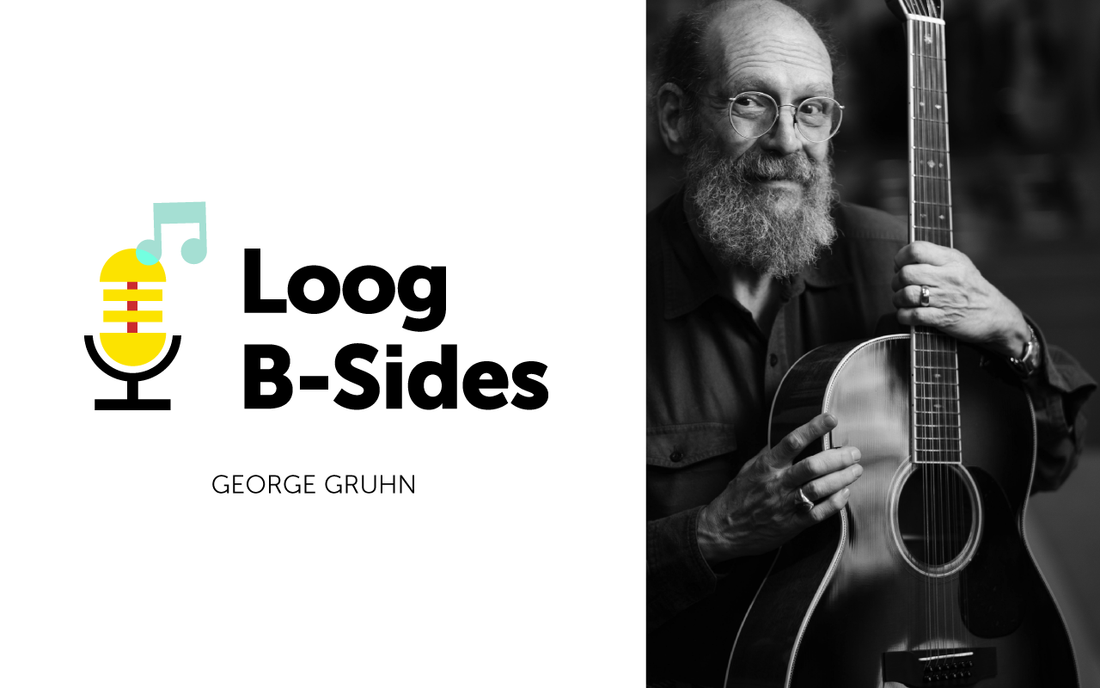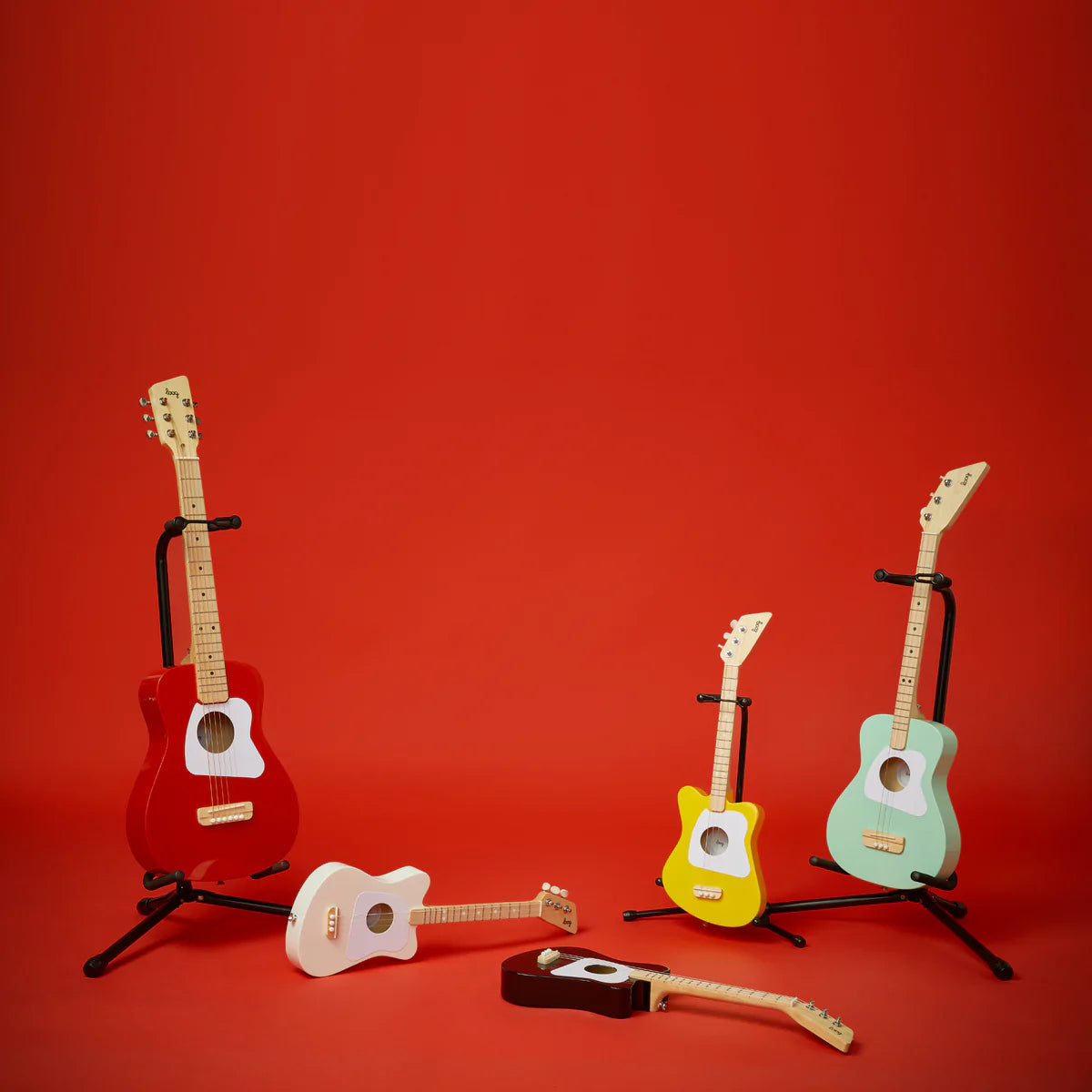
Loog B-Sides: An Epic Conversation with George Gruhn

This is the second episode of Loog B-Sides, a series of conversations that celebrates and shines a spotlight on some of our fave Loog Community members. You can also listen to excerpts from this feature and others from Loog B-Sides on Spotify.
Gruhn Guitars has been selling vintage and new guitars to some of the most-respected musicians, collectors and overall big names in music for the last 50 years. Eric Clapton, Brad Paisley, Lyle Lovett, Emmylou Harris, Billy Gibbons, Rick Nielsen, Vince Gill, John Hiatt, Hank Williams Jr, Robert Plant, Mark Knopfler… you name it. A Nashville landmark, George Gruhn’s guitar store is a mandatory stop for any music aficionado’s stay in the city, and getting to actually talk to the big guy himself is one big treat: no one knows their guitar history as well as George.
Last year, we had the honor of sitting down and doing just that. From NEVER having listened to a Clapton record (only in person, of course), to what snakes and insects have to do with guitars, to Baby Boomers’ effect on the guitar industry - here are some highlights of this epic trip down music history lane.
Don’t feel like reading? You can also listen to an excerpt of George's interview on Spotify.
You’re the number one expert on vintage guitars in the US. From what era are the best guitars from?
When I first opened the shop, I was a vintage guitar dealer and I was very openly critical of the quality of new instruments. And I think rightfully so at the time, they just were not very good. The professional players, people like Clapton and Crosby, Stills, Nash & Young. I sold a Dobro guitar and a Duane Allman in ‘69. I didn't have a store yet. We didn't want new guitars. They didn't sound as good as the old ones. I've been dealing with Eric Clapton since 1970, and even now he buys vintage guitars from me, but occasionally some new ones.

George Gruhn in the original Gruhn Guitars store on 4th Avenue in Nashville, which measured 20 x 60 feet. Picture Credit: Gruhn Guitars
Now, a lot of new guitars now are better than what was made 50 years ago, but 50 years ago, and that was 1970, it was the time when some of the worst quality instruments in American manufacturing were produced. So the guitars of the pre-World War II era, those acoustics are great. The electrics of the 1950s through about early 1965 are fabulous. But the ones made after that really are not so good.
These days a 1970 guitar is 50 years old, but it's not a golden-era instrument; I don't call it vintage, I don't call it golden-era. But the problem is when I opened up my store, a Fender Broadcaster was 20 years old. The oldest Stratocaster in the world was 16 years old. Well, that means the Broadcaster is old today. It's 20 years old, that means 2000. Well, that's not a vintage instrument, but that was a vintage instrument. In 1970, it was a golden-era instrument. It was very different from what was available and the differences were very dramatic.
In 1965, at the beginning of the year, Leo Fender sold his company to CBS and the quality went. I remember very well because I'm old enough to have been there in 1966, I compared some new Fender guitars to 1963 and 1964 guitars, and it was different as night and day. The late sixties stuff is not as good as the early sixties Gibson flat-tops, but the Gibson electrics were really quite good through early ‘65, the flat-top quality. The very best were pre-World War II, but they still made some very good ones in the fifties.

George Gruhn plays a circa 1950 Gibson Super 400. Picture Credit: Gruhn Guitars
At Gibson and at Fender, it was a management change. Fender got sold to CBS and after that, it was not the same. CBS sold Fender in 1985 to the people who were the predecessors of the current management and quality started going back up. And for Gibson, Ted McCarty, the company President, left and quality started just going right downhill. They put in a new company President who was more interested in cutting corners and saving money, and he didn't know how to play guitar. And they made guitar-shaped objects that didn't sound right or feel right. And then in 1970, CMI sold it to Norlin, and Norlin, they didn’t know guitars from a boat paddle. And that's when the quality of the Gibson acoustics in particular just absolutely went to hell in a handbasket, the quality was bad.
What about guitars made today?
The interesting thing is the guitars made today by Martin, Gibson, Fender, are way better than what they made 50 years ago or even 40 years ago. So age alone is not what makes a guitar good; it has to be good on day one.
It's harder to get good wood than it used to be, but there's still good wood around. And human ingenuity is still there, and the ability to design things right. If you care about what you're doing, it can still be done. And the quality is good. It's perfectly possible to make good instruments. Now, you don't need to get a vintage or a golden-era instrument to go on stage and play.
The other thing to keep in mind is very few people today actually hear the true sound of an instrument when their performer is playing it because people come to me, sometimes they say, “I want a guitar that sounds like James Taylor's guitar”. And I say, “well, have you ever heard James Taylor's guitar?” “What kind of stupid question is that? Of course, I have. I have every recording he ever did at any time. He plays a concert within 300 miles of where I live. I go and I see him darn well, I know what his guitar sounds like.”
“That's not the question. Have you ever, with your ears, picked up vibrations in the air that were created by the string, activating the soundboard of his guitar?” If you're sitting in the front row at his concert, he's playing his guitar with a pickup in it, and there's a wire coming out the endpin. And that's going into a mixing board with somebody there adjusting all the tones, and then that's coming out to the house PA. You didn't hear his guitar. Did you sit in a quiet room with just him playing guitar with no microphone? Then you heard his guitar.
Most of these people have never heard any of their favorite artists’ actually producing an acoustic sound, have the sound waves of that instrument hit their ears.

I don't listen to much recorded music. I hear a lot of music, although not as much lately. I used to go backstage to the Opry three or four times a week. I was there more than a lot of the performers were and I'd hang out backstage, not to watch the stage show, but to get in on all the jam sessions backstage and to talk to people. And I greatly miss that because right now they don't have Opry shows because of the Coronavirus. I don't hear any live music other than whatever's played here. I've heard Eric Clapton play live acoustically right in my building. So I know what he sounds like acoustically with no mic. I've heard him do shows anytime he's in Nashville. He invites me to his shows, but I've never heard one of his recordings.
How does your scientific background come into play with how you select and categorize the instruments available at Gruhn Guitars?
I didn't have much interest in music at all until high school. My academic background is all in zoology. My father was a pathologist. I was out collecting insects with him on nature walks when I was four years old. I caught my first snake when I was eight years old. I've had snakes ever since, I have about 20 snakes in the office right now.
I use the exact same observational skills and techniques for the identification of instruments that a zoological or a botanical taxonomist would use, someone who does the classification and identification. But the basic methodology, how you examine things, these instruments have structure just like an animal or a plant does, and they evolve over time. For example, I mentioned earlier that electric guitars and amplifiers didn't exist before talking movies. The basic electronic technology evolved from that, which came before. What came shortly before electric guitars were radio and talking movies. In order to do radio and talking movies among other things to do electronically, you needed microphones. And once you figured that out, it was a short step to figure out that, you know, what can we do to make guitars louder? Mandolines louder?
Do you keep any guitars for yourself? Are any not for sale?
Well, actually some of them are prototypes of models I designed over the years and I saved those. Some of them are instruments that I just really like, so I kept them. Sometimes it's instruments that I really, really, really liked, but no one else seemed to care. They're not necessarily the most expensive things that come through. Last month we sold a pre-World War II D-45 Martin for $350,000. I used to be able to collect those, but they're not affordable anymore. When I started out in business, one of those would be worth about $5,000. Even if I got one cheap, that's that much money I'm taking out of the business. Back in ‘76, I was able to keep things like that. And I had six pre-War D-45’s, and I had a bunch of other things, which today would be worth a fortune if I still had them.

But the market went down. See, it used to be that there were two times in a person's life cycle when they would buy guitars. Are you familiar with the concept of imprinting? Baby duck hatches, looks up, sees mama, follows mama around, at the end of the day it knows it's a duck, and for the rest of its life it knows it's a duck - that's hardwired in. But musical stuff, people get hardwired on their musical preferences and a lot of what they are going to be for the rest of their life. Not when they’re listening to Sesame Street at age four or five, but when puberty kicks in: that's when your hardwiring for musical preferences stay with you for the rest of your life. And it used to be that people would buy guitars from about puberty through age 25, and then they didn't buy guitars at all again until they retired, whereupon they went back to the music that was popular when they were of dating age, they'd have another mini-boom up for that.
Does this still happen?
Baby Boomers are different from any human generation that preceded us. We are the first human generation ever that took for granted that we would live to grow old on average. That our life expectancy wouldn't be like at 1900, where nobody got as far as first grade without knowing personally about playmates who had died. So what did the Baby Boomers have that caused them to have a different attitude toward mortality? My parents grew up in the Depression; antibiotics did not appear until they were adults. The average lifespan has gone way up and, as a result, Baby Boomers are the first human generation that had a midlife crisis.
When they hit age 40, Baby Boomers were now in a family situation: they're 40, they're well-established, they've got money saved up. They've been doing well, the kids are now old enough, they won't wake up and be bothered if you play at home when you get home and so you feel like you're going to go get some instruments. So, right around 1980, late ‘84, early ‘85, all of a sudden, I was getting calls from 40 year-olds wanting instruments that were popular when they were of dating age, starting out with things like the folk music-boom instruments (‘59 to about ‘63), the Beatles, Rolling Stones type rock boom (‘64 through about ‘68), and then folk-rock (‘69 to about ‘75).
What about Millennials? Check out what George has to say in this awesome video by The Tone King.
Then it went down and the guitar sales plummeted. Companies like Martin, Fender, Gibson were in deep trouble. Their sales plunged and the Baby Boomers had dropped out and Generation X would rather watch sports or play the newest versions of video games like Pac-Man or something. They weren't interested in guitars, or if they did, the music was disco and some funk and stuff that wasn't very guitar-centric. Now, at the NAMM shows, they have a whole section for disco equipment, DJ equipment. There are no instruments. It's a different thing. But the fact is there are still people who want guitars, but the guitar does take a certain degree of discipline. On the other hand, the basics of how to play a country music tune is something I could give somebody a minute and a half long guitar lesson.
Have you ever been a guitar teacher yourself?
I remember one time in 1965, I'd only been playing guitar for two years. I got a call from a guy, Pete, at the fret shop in Chicago, walking distance from the University of Chicago. The teacher, Carmie Simon, was out sick and he had a beginner's class that afternoon, it was going to be in another hour. And could I come over? He'd give me $10. I skipped a class. 10 bucks in 1965 would buy more than a hundred dollars would buy today. So I say, “okay, kids show me what you've been doing.” And they showed me these pretty little arpeggios and exercises that I'd been playing for two years and I couldn't do it. I didn't know that stuff. So I said, “you know, I got to tell you something here. Do you ever use a flat pick?” “No.” I said, “here,” handed out flat picks for everybody, showed them how to hold a flat pick. And I said, “now, we're going to just show you how to pick a tune by ear. Have you ever done anything like that, ever?” “No.” They never had. “Has anybody shown you how to do something like that?” “Well, no. I mean, you have to be playing for years to be able to do that.” “No, you don’t.”
So there were 10 kids in the class and at the end of one hour, five of those kids were picking out tunes by ear. The other half of the class was not happy. They didn't get it. I hadn't given them an exercise to practice and do by memory and bring back the next week; I gave them something that was different. But the other five - their eyes were lit up. They were inspired, and I knew pretty well that by the end of one year, those kids were going to be playing better than I did.
You can listen to an extract of George's interview on Spotify.

